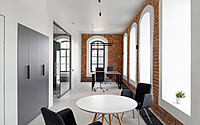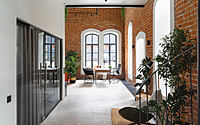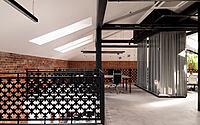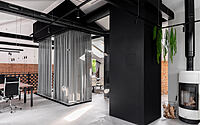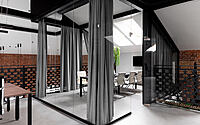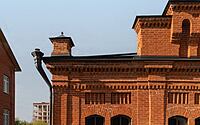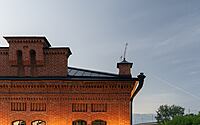The Historic Power Station by Brusnika Design
The historic power station, located in the Russian city of Yumen, is a magnificent restoration project by Brusnika Design.














Description
Brusnika develops and builds new housing estates in cities of Russia. However, it is also committed to conserving architectonic heritage related to its projects. This approach restores the historic background of modern districts and enhances place identity. Riverport, a new housing estate under construction in Tyumen, is a vivid example of this trend. Located in the former river port, which marked the history of Siberian steam navigation in the late 19th century, the estate will comprise a total of 15 houses. Public space development, along with the city waterfront revamp will be further endorsed by a multifunctional environment with shops, shopping malls, offices, coffee houses, and restaurants. The estate is due for completion in 2030.
The new estate in the river port borders a historic power station. Ivan Ignatov, a local merchant, steamboat, and machine plant owner constructed it in the 19th century. It was the first private power station in town, lighting the quay, the steamboat office, the merchant’s house, and a neighbouring monastery. Operational until the 1980s, the building was listed as cultural heritage in 1994. Unique masonry and redbrick style, so popular in Russia, validate its architectonic status.
Until 2015 the building was neglected, falling into disrepair. Filled with rubble and overgrown with weeds, it also had crumbling walls, ruinous foundations, and a missing roof and windows. At this stage, it was auctioned, and purchased by a local entrepreneur Sergey Voblikov, reputed in Tyumen for restoring historic buildings and adapting them for commercial purposes. The power station project was based on the same scheme. The restoration works, however, were hindered by garage clusters, an industrial estate, and dilapidated houses in the neighbourhood. Even if the building was fully restored, it would be complicated to grant it a fresh lease of life, given its location. The area around the power station was neglected and depressed until Brusnika’s redevelopment project, launched in 2019. So the power station had to be embedded into the new Riverport spatial environment at the masterplan phase. Upon completion, a landscaped public square with recreational facilities would be constructed in front of the building.
The power station restoration took around seven years. The repair works comprised strengthened foundations, renewed roofing, waterproofing, and restored brickwork. The architects then redesigned the interior of the building so it could serve a different function. The core of the building, designed as an independent metal framework not adjoining the outer walls, was transformed into a central mezzanine. The lower level of the structure comprises all utilities and rooms requiring no daylight, while the building perimeter remained open and double-height. When the works were completed in 2022, the building was approved to host Brusnika’s office.
The key emphasis in interior design was to retain exposed brickwork rhyming the facade. This technique, along with large arched windows, enhances the historic mansion effect. The ground floor houses conference and negotiations zones. The mezzanine hosts an open-plan administration office, which can be accessed by a spiral staircase. Some decor elements reference the river port area: the entrance wall is decorated with a geometric pattern featuring portal cranes (the original ones can be seen in the new housing estate). Numerous artefacts were uncovered during restoration, such as rails produced by a renowned plant or bricks bearing a mason’s mark. They are carefully preserved to become part of the interior. Conceived as another historic river port exhibit, a building made up of several cargo containers will be constructed in the area.
Photography by Maxim Loskutov
Visit Brusnika Design
- by Matt Watts



